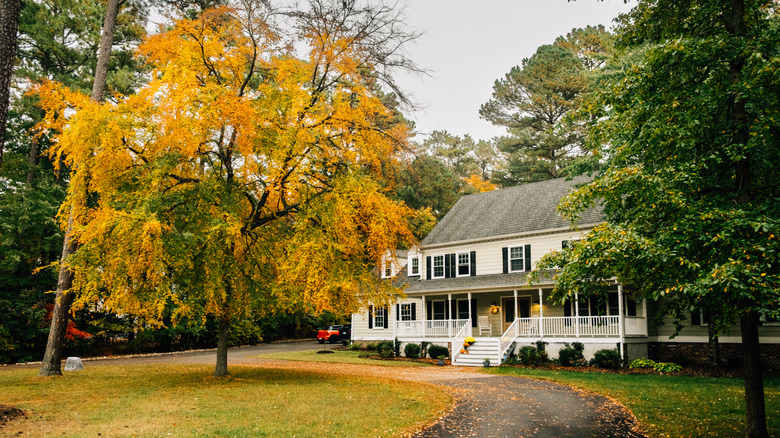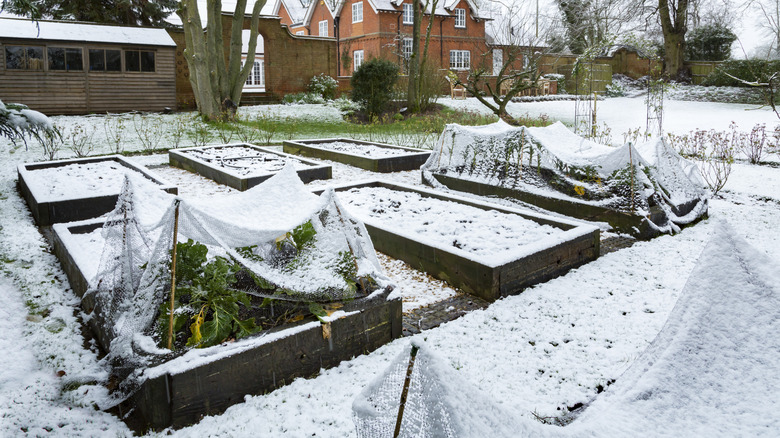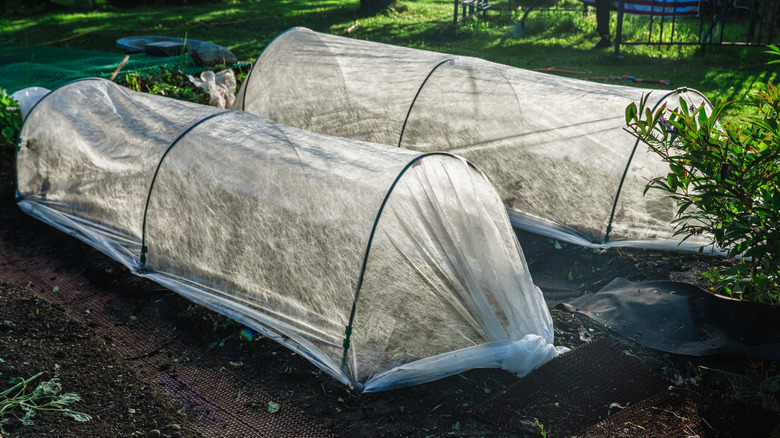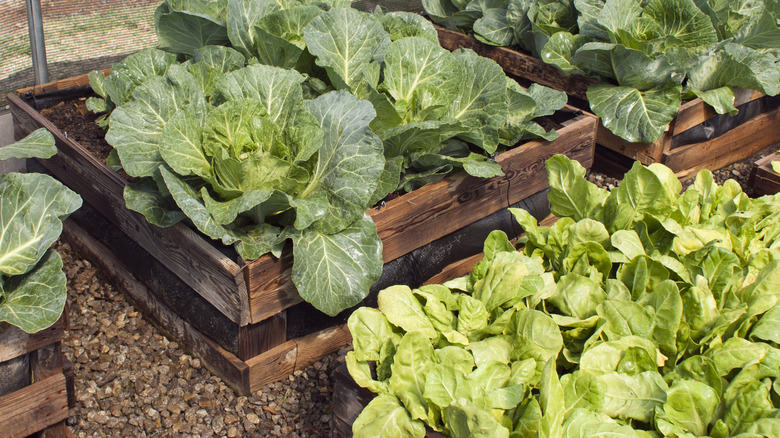What The Old Farmers' Almanac Predicts For November And How It Affects Your Garden
If you're wondering what to expect for November and Thanksgiving weather-wise, the Old Farmer's Almanac might give you a clue. This publication has predicted the weather since the year 1792, relying on a special formula to calculate long-range temperatures each month. The information can be vital to gardeners so they can plan for the best harvest or blooms, as well as when they should start protecting plants from frost.
This year, this long-running publication predicted fall should feature warmer weather than usual, with temperatures trending higher than expected in many areas of the United States. If you're an avid gardener, this may mean you can enjoy a longer season for some plants and have more time to clean up your garden. However, it may also worsen pest problems in your garden compared to previous years, and your plants may also stay active longer, postponing dormancy.
According to the almanac, the western half of the country should see atypical warmer weather, while other parts of the country should see a cooler fall, so bundle up accordingly. Because the ground freezes when temperatures dip below 32 degrees Fahrenheit, this can pose a challenge if you're planting hardy bulbs for spring blooms. Adjust your planting and gardening tasks to cooperate with the weather, taking advantage of any mild periods to get ready for spring.
November weather for Northeast to the South
It may be a cold, chilly month in the Northeast Corridor (New York, Maine, Vermont, New Hampshire, and Massachusetts) as they see snow showers early. Snow and cold may linger throughout the month, until warmer days give way to rain. Consider using a few DIY ideas to protect your plants from frost before the coldest days arrive, adjusting watering schedules as needed. Meanwhile, neighbors in the Atlantic Corridor (Rhode Island, Connecticut, New Jersey, Washington, D.C., and Delaware) might see more rain, followed by mild, sunny skies. This might nourish your soil, but too much water could cause soil compaction, erosion, and root rot. Try to prevent overflow with helpful drainage solutions such as rocks or gravel in your garden.
The Appalachians may have atypically colder weather, particularly in the south. Expected average temperatures are 43 degrees Fahrenheit, with rain and cold in the north, followed by a possible snowstorm the second week. Periods of sunny days with chill and rain follow. Down in the Southeast Corridor in North Carolina, South Carolina, and Georgia, prepare for sunny conditions. It should be an average of 55 degrees Fahrenheit until the second week, where you may see chilly precipitation. This continues until the last week of November, where temperatures should be warm and dry. Farther into Florida, residents should stay alert for tropical depressions as the Atlantic Hurricane Season continues, with overall sunny weather mixed with rain. The normal average expected temperatures of 69 degrees Fahrenheit may continue with anticipated precipitation of 3 1/2 inches, an inch above normal. Mitigate any issues that can come from saturated soil by improving drainage.
What the Almanac says about the Lower Lakes, Ohio Valley, and the Deep South
Snow is likely in the forecast for the Lower Lakes region, Michigan and the areas around the Great Lakes around mid-November. First you may see scattered showers on chilly days, which will eventually become snow. Some sunny spots may be in store near Thanksgiving, with an anticipated average temperature of 41 degrees Fahrenheit for the month and 2 inches of rain projected. Ohio Valley gardeners (Ohio, Kentucky, Wisconsin, Indiana, and West Virginia) should prepare for multiple rainy days, with 2 1/2 inches of precipitation likely, though still ½ inch below average. November could mean a slightly chilly month in this area, with average expected temperatures of 44 degrees Fahrenheit. This may be a good time to look for perennials you can still plant in November and other garden tasks, such as mulching.
The Deep South (Arkansas, Tennessee, Alabama, Mississippi, and Louisiana) will likely see average temperatures of 54 degrees Fahrenheit. Heavy rain is possible in the second week of November, mostly in the northern area. Overall precipitation, however, is forecast 1 inch below normal, at 3 1/2 inches total. Keep up with watering if needed, working the soil for new plantings. Some areas in the north may even see snow, so be aware if you need to cover or bring in tender plants.
What to expect for November Upper Midwest & Heartland gardening
Up in the Upper Midwest (Minnesota, Wisconsin, as well as some of the eastern Dakotas), it will be relatively cold with an average temperature of 30 degrees Fahrenheit likely. Chilly weather starts off in the first week, dipping into very cold territory the week before Thanksgiving, with possibilities of a snowstorm in the east. The chilly temperatures continue throughout the month with possible flurries wrapping it up. Gardening will be difficult thanks to the frozen ground, so use the time to start seeds indoors and protect perennials over the winter cold snap.
It will be a warmer month for the Heartland (parts of Iowa, Illinois, Kansas, and Missouri), with average temperatures trending to 44 degrees Fahrenheit. Rainfall will be lighter as well, with 1 inch less than usual. The first should start off warm before turning colder, bringing rain and snow. Sunny days will likely continue throughout the month, with the last weeks warming up again. A snowstorm may occur in the southern areas, but overall, expect a mild, drier November.
Weather for Texas & Oklahoma, High Plains, & Intermountains
After starting off with unseasonably warm temperatures in the first weeks of November, Texas and Oklahoma gardeners might see snow mid-month. The warmth will encourage plants and vegetables to grow a little longer, but keep them protected for the cooler weather transition. Add cool-season crops if desired, taking advantage of the warmer soil and consider moving sensitive plants inside or covering them for the winter. Precipitation should remain average at 3 inches in the forecast, but may be mixed with snow in northern areas. Incoming rain will help replenish dry soil and hydrate your plants, but make sure you have adequate drainage.
The High Plains region (sections of Montana, the Dakotas, Nebraska, Kansas, Colorado, and Oklahoma) should expect mostly average temperatures of 39 degrees Fahrenheit, only 1 degree above normal. The month likely begins with sunny, warm temperatures, then by the second week develops into periods of rain and snow before turning warm again. Use the time between chilly weather to tend to your garden, as the chill sets in with rain and snow around the 15th. The rest of the month is a forecast characterized with sunny yet cold weather.
Up in the Intermountain region (parts of Washington, Idaho, Wyoming, Nevada, Utah, Colorado, and Arizona), gardeners should expect their coldest weather not to come into effect until late November, giving you time to prepare your beds. Temperatures are three degrees above normal for the region at 42.5 degrees Fahrenheit. Enjoy the more mild weather as a chance to plant and tidy before the rain or snow sets in. It may be slightly wetter than usual this November, with 1 1/2 inches expected, which is 1/2 inch more precipitation than normal.
Gardening in November for The Desert Southwest to Hawaii
The Desert Southwest (parts of New Mexico, Arizona, and Nevada) should see its coldest days in November, with a few snow showers anticipated for the eastern part of the region in the second week. Periods of rain are also expected, but the western areas are likely drier than usual. Gardeners should expect to water more frequently and should plan for cool-weather planting. The Pacific Northwest (Washington and Oregon, plus the tip of California) is likely coldest in the latter half of November and may see ample precipitation at an average of 7 inches. Ensure soil drains well and plant anything for spring before it gets too chilly. Not far away, the Pacific Southwest (most of California) should have mostly sunny conditions this month, with some cool rainy periods mixed in. Prepare your garden beds for cool-weather plants, and keep up with watering for the season.
Alaska gardeners are likely in store for a chilly November, with temperatures 2 degrees warmer than usual expected. With the outdoor growing season definitely over, it's a good time to start winter sowing seeds by starting them indoors and other tasks for preparing your garden for spring. The weeks should be filled with rain mixed with snow, with likely flurries in the north, and a possible snowstorm near Thanksgiving. As for Hawaii, November will be a very wet month, with precipitation 6 inches above normal for the eastern area. The central and western islands have less rain expected, however, with the overall average of 3.8 inches. Temperatures should be a little cooler than average at 76.5 degrees Fahrenheit.





